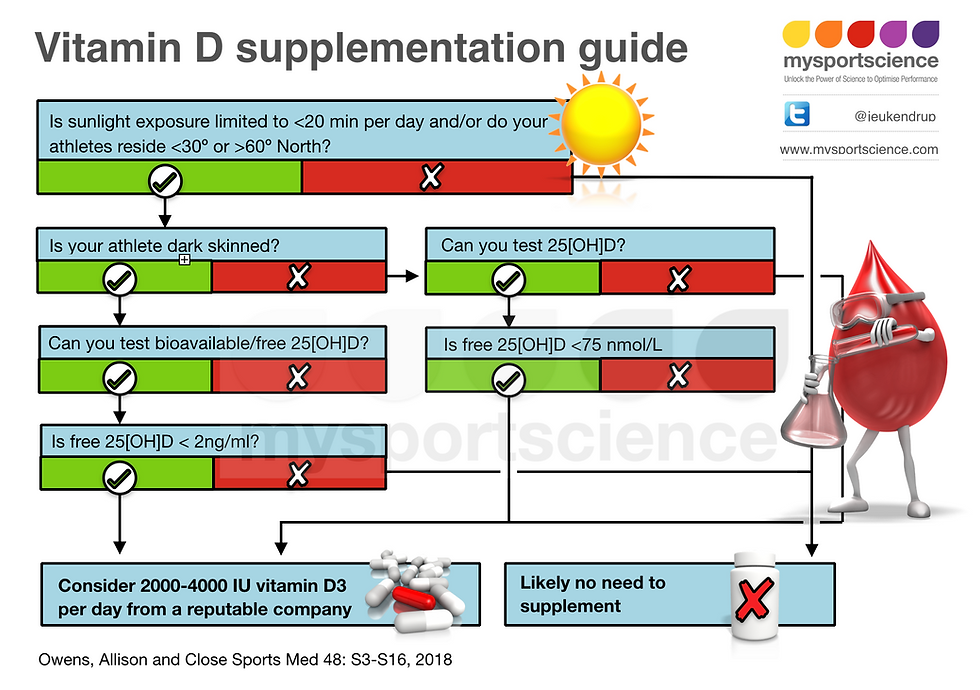Vitamin D supplementation guide
- Asker Jeukendrup
- May 3, 2020
- 3 min read

In recent years Vitamin D has received a lot of attention. The numbers of publications on Vitamin D have sky rocketed as have the sales of various vitamin D supplements. However, there is a lot of confusion and misinterpretation of the available evidence. This has resulted in unguided supplementation of sometimes very large quantities of vitamin D, especially in sports.
Vitamin D is mainly obtained through exposure of the skin to UVB through sunlight, and a small amount typically comes from the diet. Studies indicate that during the winter months, athletes who live at latitudes above 30°N do not get sufficient sunlight to synthesize vitamin D3 in their skin and consequently may develop inadequate or deficient vitamin D status. However, there is still discussion, even amongst scientists, what inadequate or deficient is and how it can be measured. For a more comprehensive review of the literature the reader is referred to an excellent review by Owens et al. Here we will focus on the basic questions:
What are the effects of vitamin D?
Should we supplement with vitamin D?
If so, when?
And how much?
Effects of Vitamin D
Originally the role of vitamin D was mainly studied in relation to bone health. Vitamin D is required for the normal absorption of dietary calcium, and deficiency of this vitamin is associated with brittle bones. Vitamin D also has a role in immune function and many studies show that vitamin D deficiency might be related to reduced immune function. But vitamin D has also been associated with muscle function. There are suggestions that vitamin D supplementation might affect muscle strength, endurance, and athletic performance.
The latter has received considerable attention over the past decade, and the general consensus at present is that vitamin D deficiency could negatively affect athletic performance due to the influence of vitamin D on muscle function. However, there is insufficient evidence from a limited number of cross-sectional vitamin D status studies and longitudinal, randomized, placebo-controlled vitamin D3 supplementation studies in athletes to conclude that vitamin D is a direct performance enhancer (Girgis et al. 2014). We simply need more and better studies. However, it is certainly questionable if vitamin D supplementation has any effects in athletes who do not have a vitamin D deficiency.
On the other hand high dose vitamin D supplementation may be toxic and even though few cases of Vitamin D toxicity are known, caution should be exercised and frequent high dose supplementation should be avoided (unless there is very clear medical indication).
Decision making
Owens et al (2018) developed a decision tree for the use of vitamin D supplements (see infographic). This will help with making decisions. A decision is best based on measurements of vitamin D status. Thus if possible vitamin D status should be measured. This is where it gets a little tricky. Vitamin D status is often measured by assessing the metabolite 25[OH]D in blood. It has been shown, however, that this “standard” measure may not be a good indication in athletes with a darker skin. In this case bioavailable or free 25[OH]D should be measured. If values indicate deficiency or insufficiency, supplementation should be considered.
If it is decided to supplement a dosis of at least 2000 IU is recommended up to 4000 IU.
Supplementation should be considered only for the months that exposure of the skin to UVB through sunlight is limited.
Of course this is only a short practical guide to vitamin D supplementation based on the latest evidence. I would highly recommend reading the review mentioned here by Owens et al or other work from Graeme Close and his team on this topic. Click here for the full article.
References
Girgis CM, Clifton-Bligh RJ, Turner N, Lau SL, Gunton JE. Effects of vitamin D in skeletal muscle: falls, strength, athletic performance and insulin sensitivity. Clin Endocrinol (Oxf). 80(2):169-81, 2014.













Comments